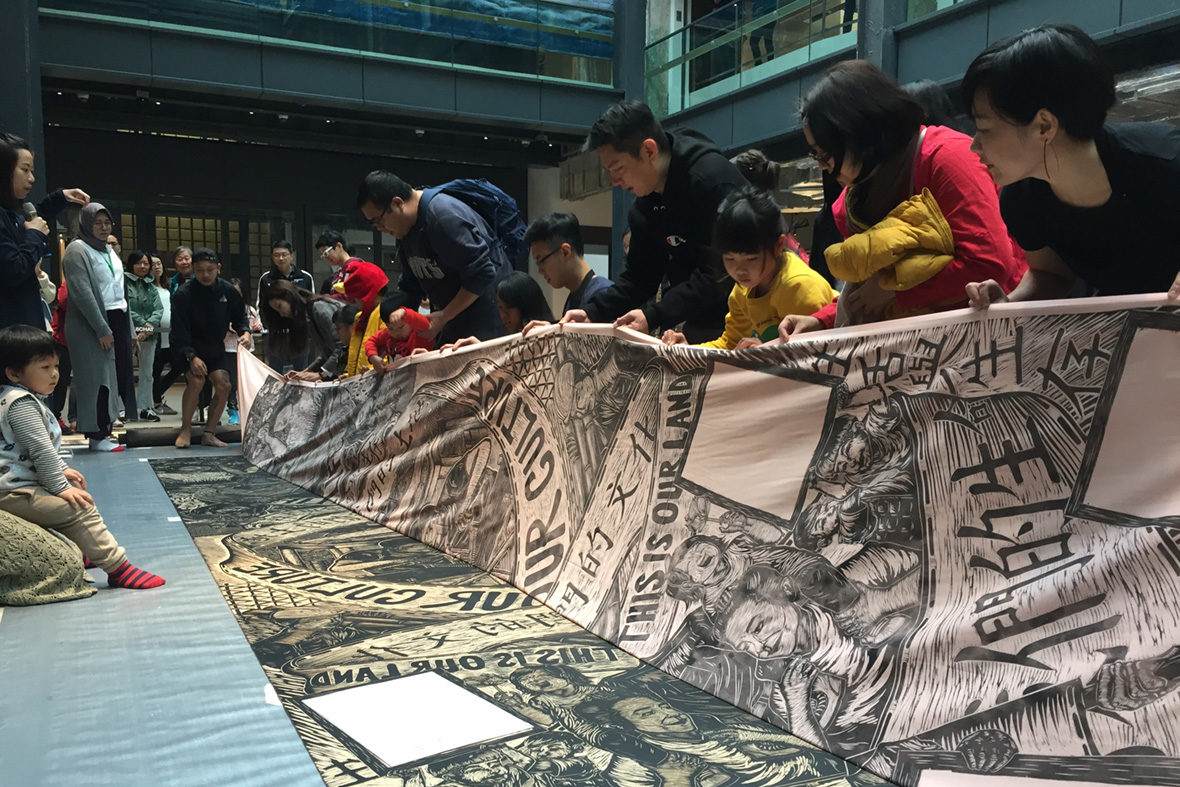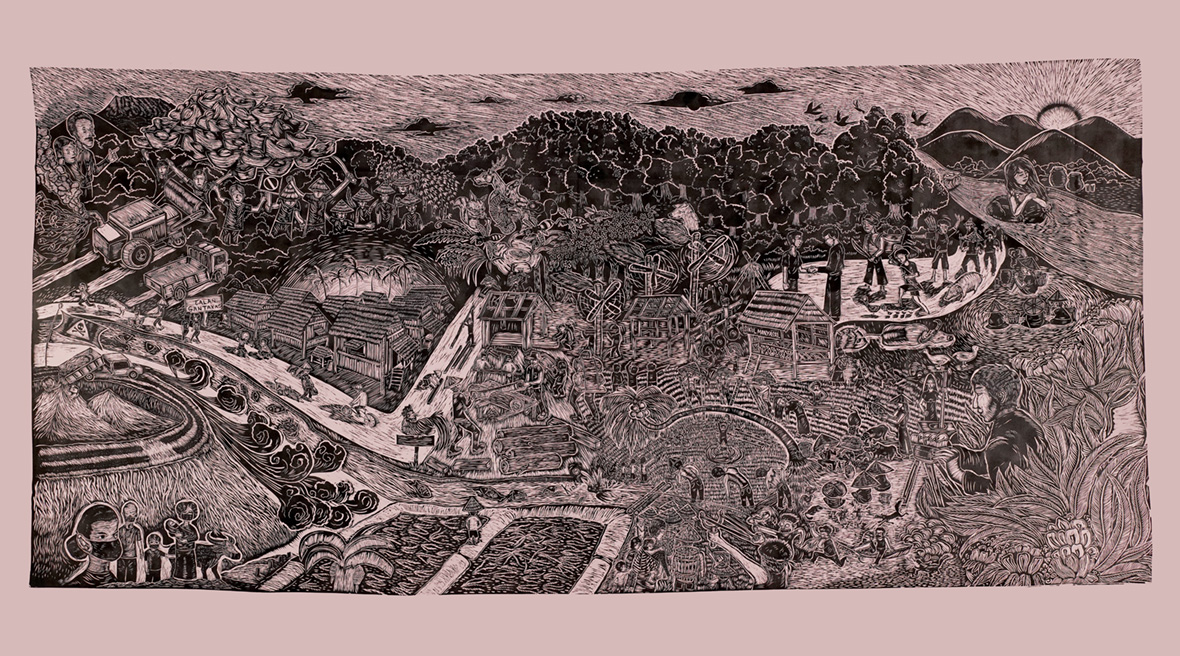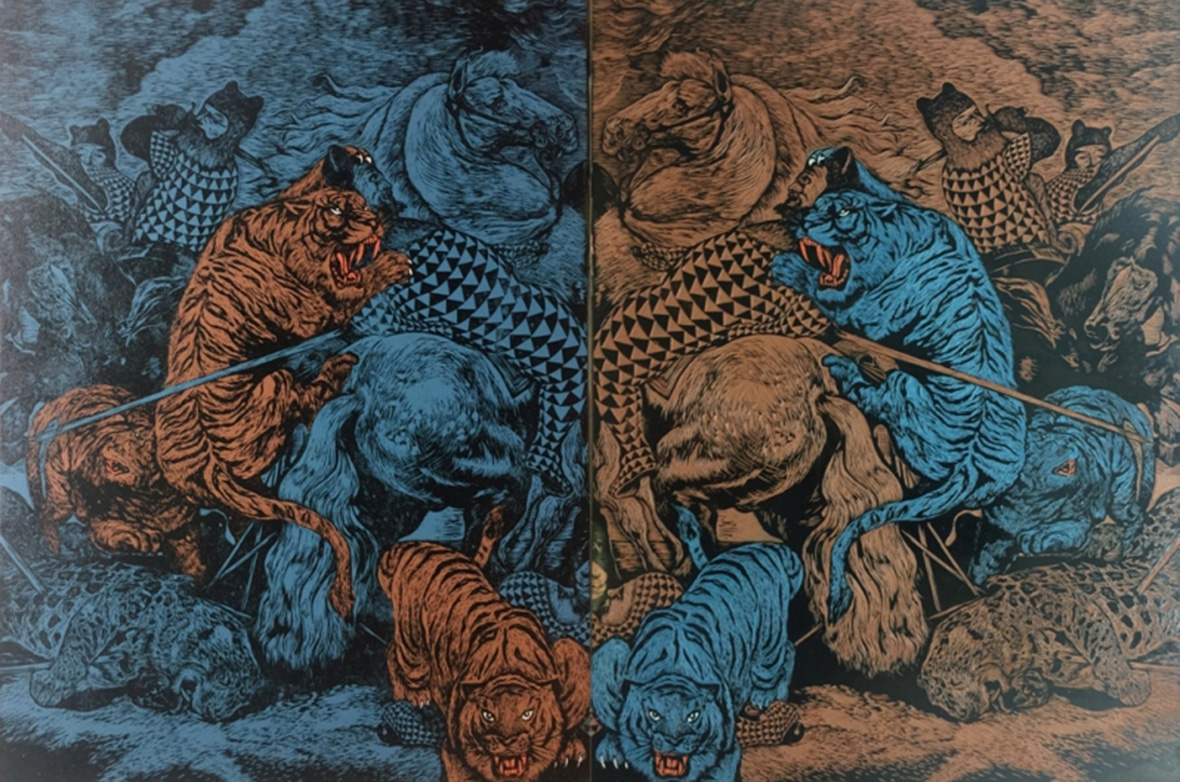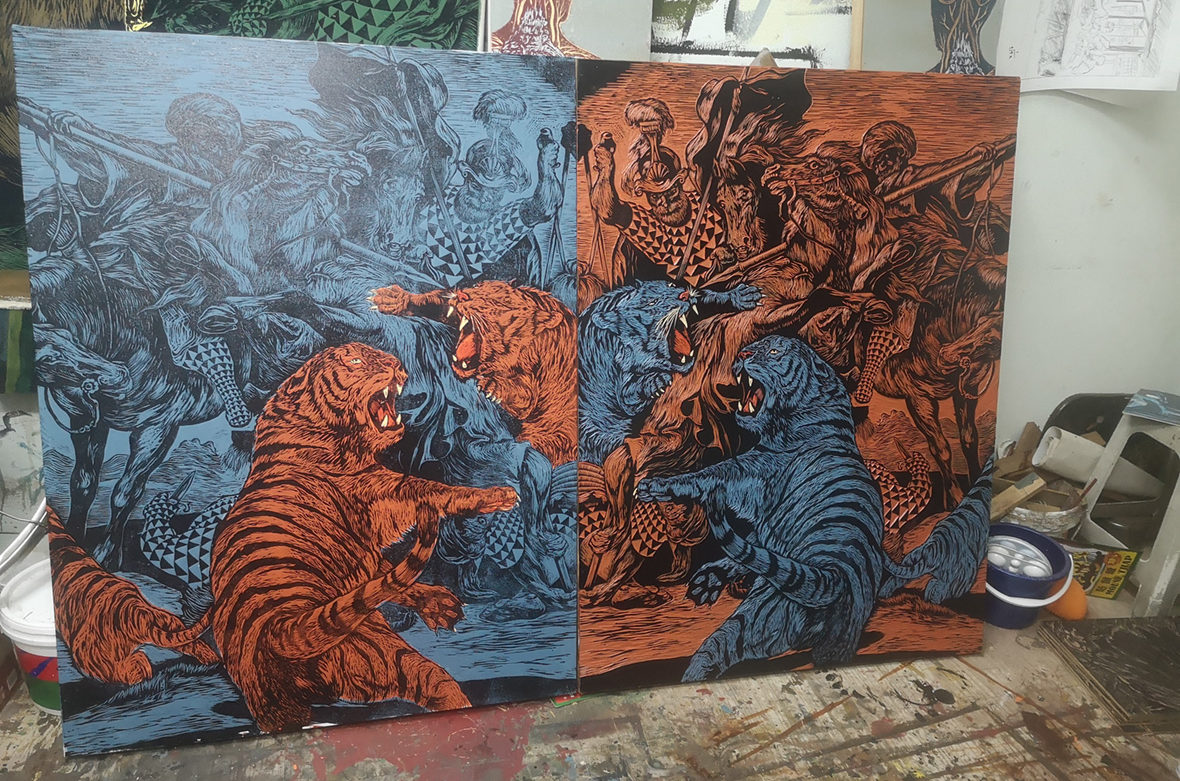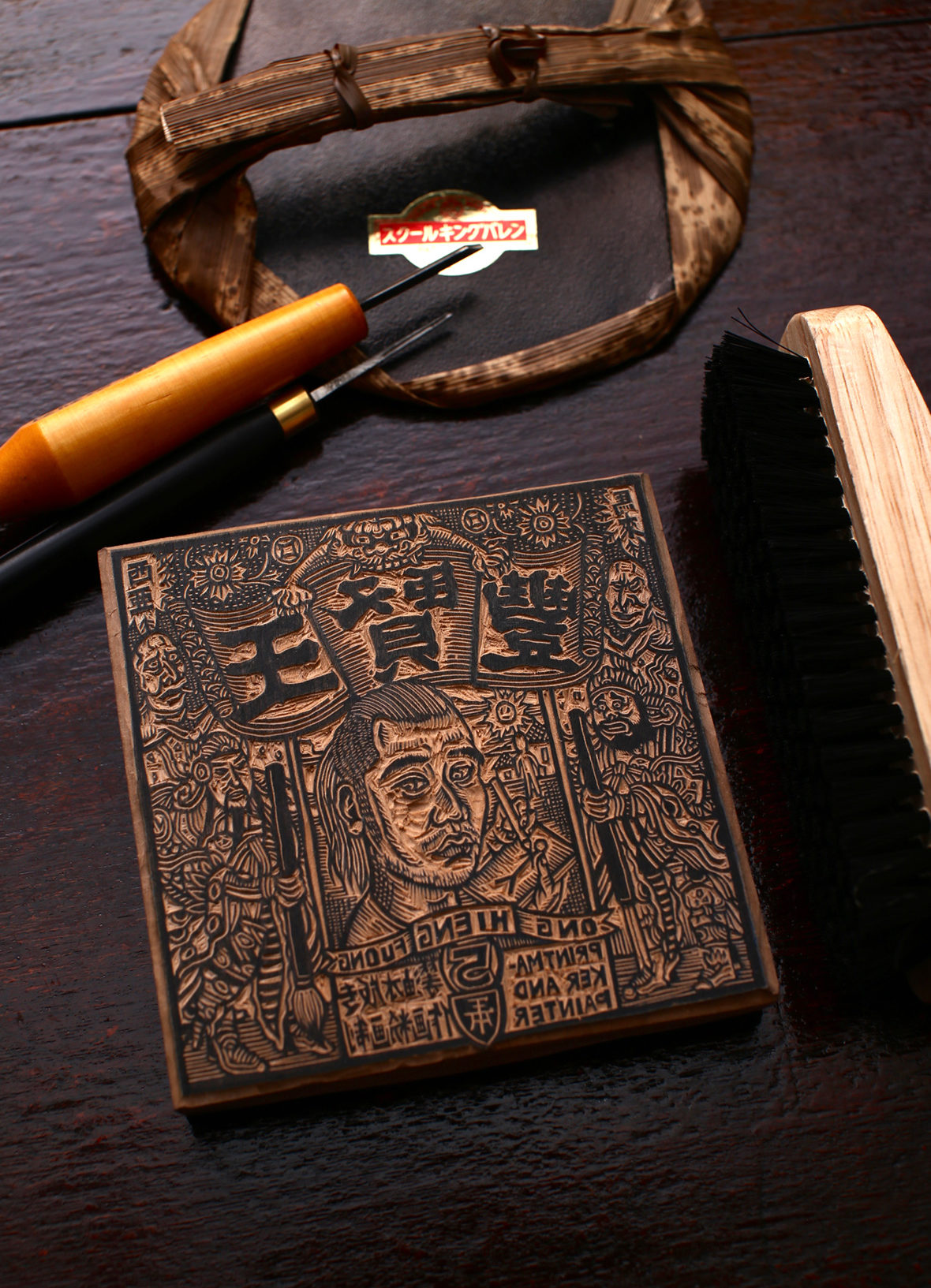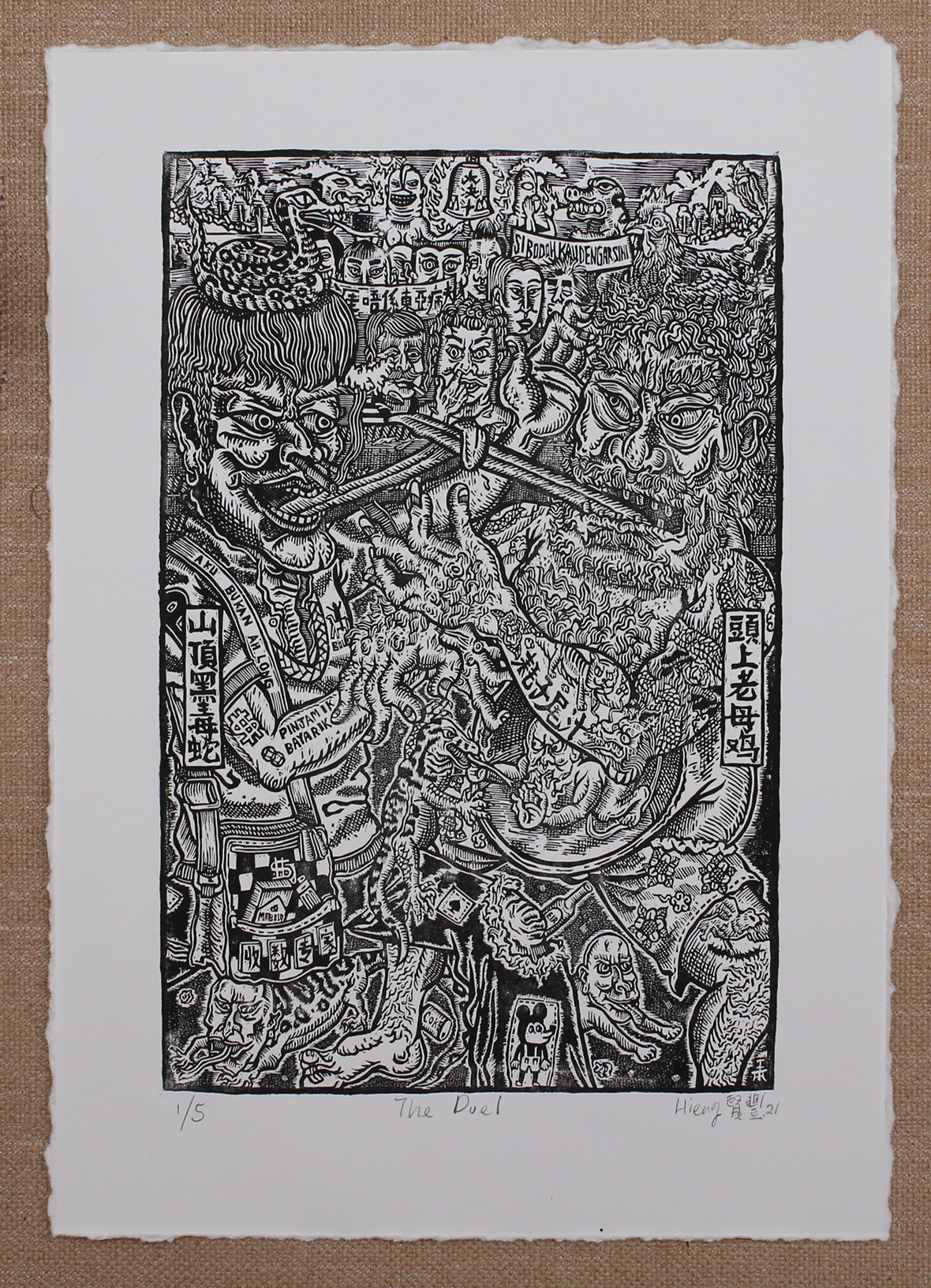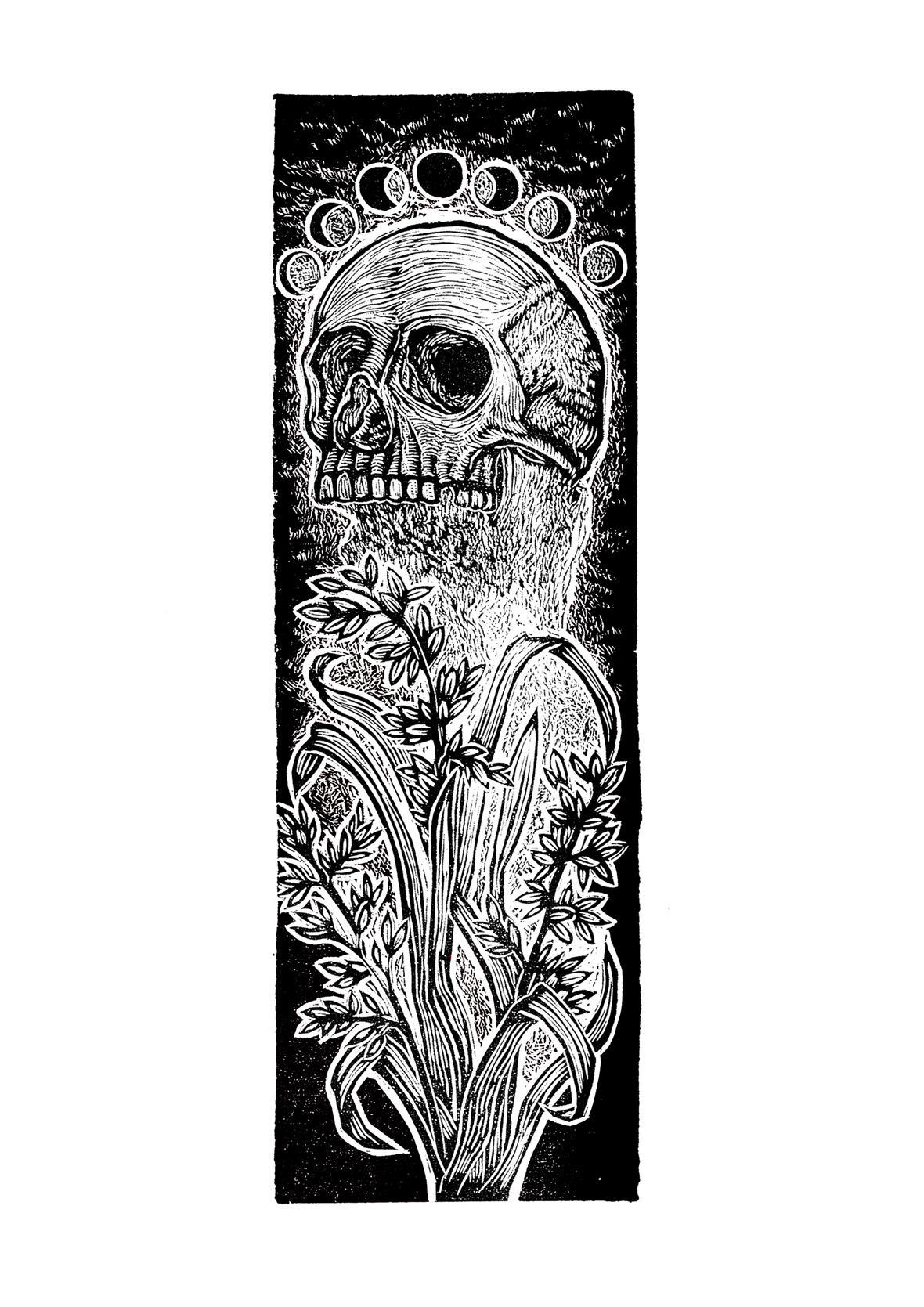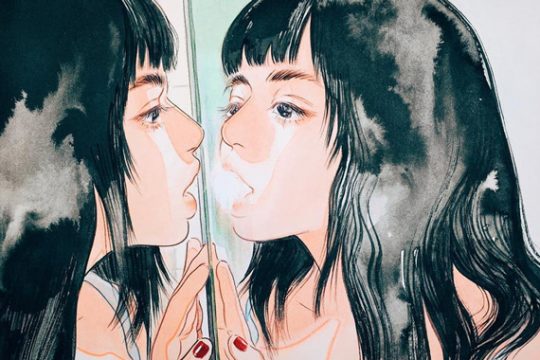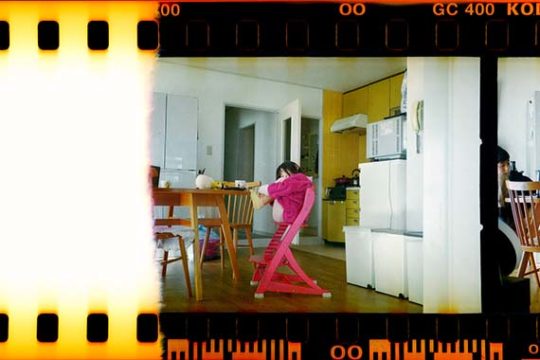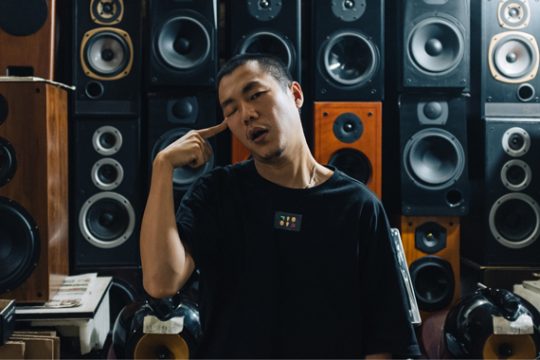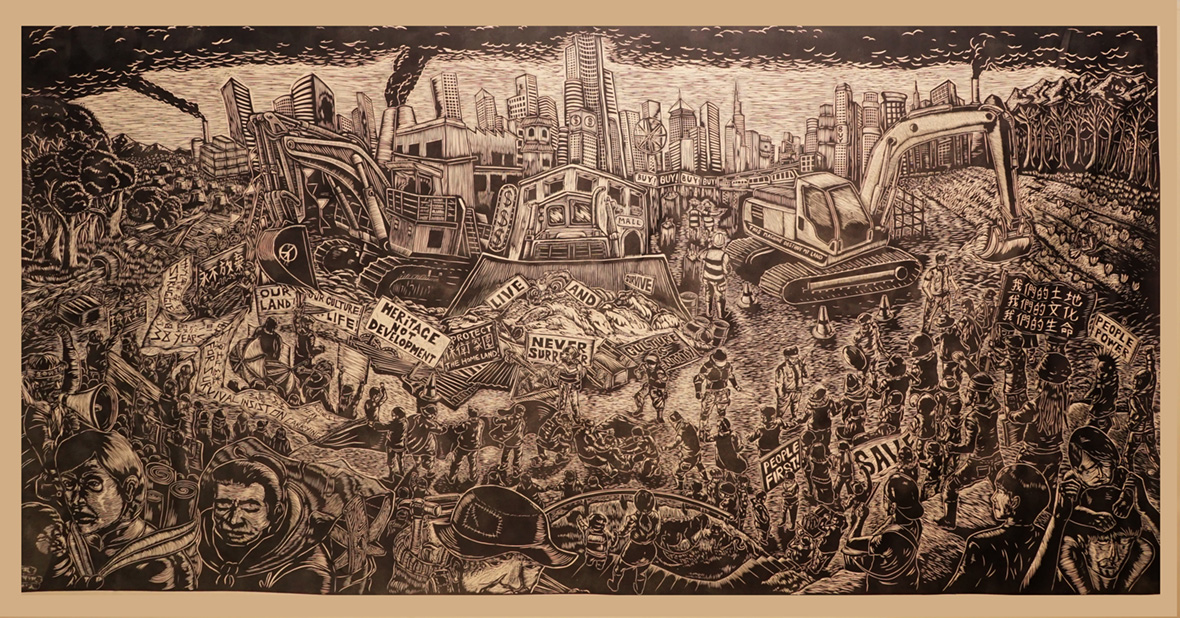
A mad city looms in the distance, its towering smokestacks sending plumes of black pollution into the clouds. Excavators and a bulldozer spread out from its center in all directions, laying waste to everything in their path to make way for cash crops and malls. Riot cops face off with protestors, blocking their advance. In the foreground, displaced villagers retreat into the hills with children and belongings on their backs, forming the final ring of this rippling drama. This is Live And Survive by the Pangrok Sulap collective. It’s easily one of Malaysia’s most powerful pieces of contemporary woodblock print with its massive size, intricate detail, powerful composition, and resonant messaging.
The piece is also emblematic of what artists in the country are creating with the medium today, in both style and subject matter. Embracing the raw strokes natural to carved wood and monochromatic color schemes, many Malaysian woodblock artists are using the medium to call attention to the pressing environmental issues of modern times.
末世之城伫立在远方,滚滚黑烟从陡峭的烟囱升入云层。挖掘机从市中心涌向四面八方,摧毁眼前的一切,只为建造商场和金钱大楼开道。防暴警察与抗议者对峙,流离失所的村民落荒而逃,为这波澜起伏的故事划上句号。这是艺术团体 Pangrok Sulap 的作品《Live And Survive》(活着) ,其画幅恢弘、细节复杂、构图庞大,一笔一画令人为之着迷。这很可能是马来西亚最令人震撼的当代木刻版画作品之一。
这件作品也是当地木刻版画创作风格和主题趋势的缩影。近年来,越来越多马来西亚木刻版画艺术家以原始的雕木笔触和互补色彩 (Contrasting Colors) 来创作,试图提高人们对当代环境及传统继承问题的关注。
While still a minority area of interest among the current crop of Malaysian talents, there are now several accomplished artists working with the medium. It’s a close-knit community, with many people working together in collectives like Pangrok Sulap and Taring Padi. Even those who haven’t worked together aren’t shy in praising one another in interviews. Woodcarving artists are scattered across the country, but most of them come from the countryside, which might be why the natural environment features so heavily in their work.
Woodblock printing has roots stretching as far back as the 200s in China. Advanced methods of the printing technique had spread widely across England and Japan by the 1500s and 1600s, and Mexico adopted it for political messaging at the start of the 20th century. Printmaking didn’t emerge in Malaysia until the 1940s, beginning with woodcut prints inspired by reproductions found in Chinese books. Artists in Singapore (still part of Malaysia at the time) taught themselves and the work of that early period mainly depicted the daily life of workers, street vendors, and squatters.
Printmaking in the country struggled to find equal footing among other forms of art like painting in the following decades, although there has always been a strong contingent of artists working with prints. With the emergence of private galleries in the ‘90s, they received more attention than ever before, but artists still generally worked with other mediums rather than specializing in print exclusively. By 2010, there was a show dedicated solely to printmakers that included over 500 entries from artists all over the world creating with the full range of printing techniques. But it all started with woodcut prints, and today’s Malaysian artists are looking back to those roots.
现如今,木刻版画在马来西亚仍然属于小众艺术范畴,但作品却能呈现出极致的水准。木刻版画艺术在当地是一个联系紧密的圈子,大家也常常围坐团体进行创作,如 Pangrok Sulap 和 Taring Padi。即使相互没有合作过的艺术家也惺惺相惜,在采访中彼此欣赏。木刻艺术家分散在全国各地,但大多来自农村地区,这可能也是他们作品中充满如此多自然元素的原因。
木刻版画最早可追溯至公元二百年的中国。到十六和十七世纪,先进的印刷技术在英国和日本广泛传播,到二十世纪初,墨西哥采用这种技术来传递政治信息。直到上世纪四十年代,马来西亚才出现版画,初期主要是受中国书籍印刷启发的木版画。后来,新加坡(当时仍属于马来西亚)艺术家自学成才,创作了木版画在当地的雏形,主要描绘工人、街头小贩和非法居住者的日常生活。
在接下来的几十年里,受到西方艺术形式的冲击,版画只能在绘画等其他主流艺术形式的狭缝中生存,但一直以来,都不乏工艺精湛的作品涌现。随着九十年代私人画廊的兴起,版画获得了越来越多关注,但依然很少有人专门从事版画创作。到 2010 年的一场专为版画家而设的展览,现场展出了来自世界各地的 500 多件作品,将丰富的版画创作工艺公示于众,为这十年的木版画发展埋下了一颗种子。所有版画工艺都始于木版,如今的马来西亚艺术家正追溯其发展的本源。
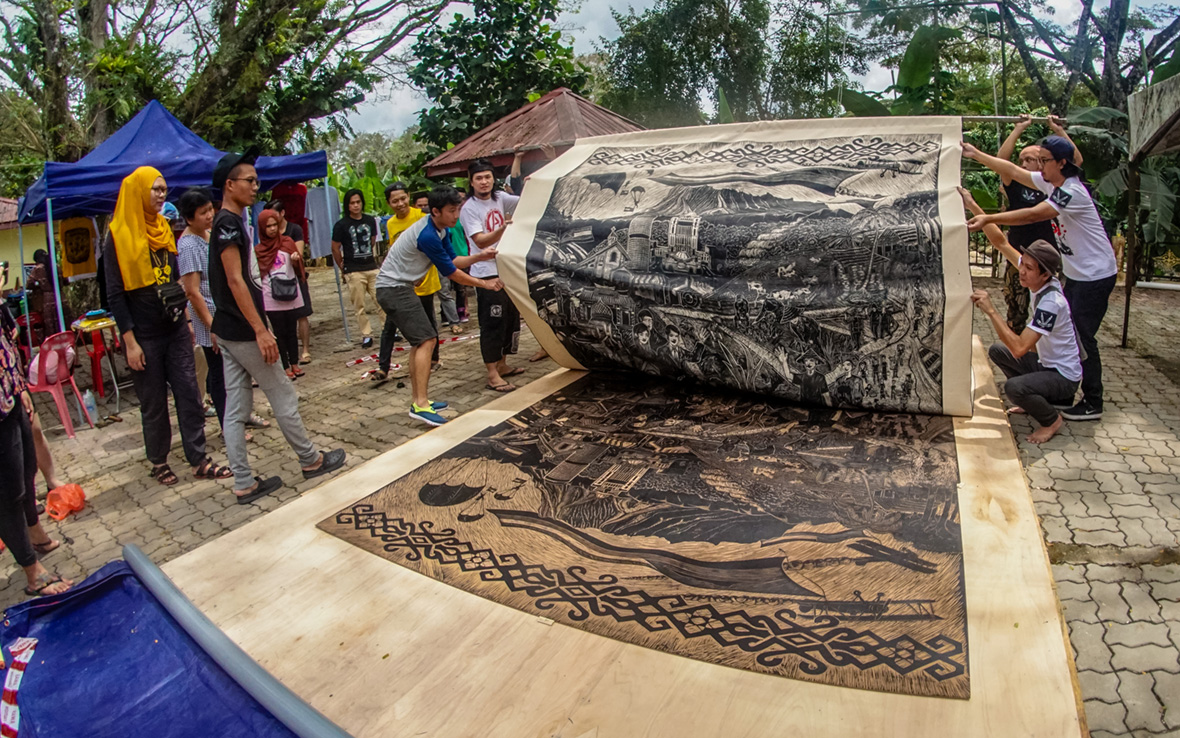
The Pangrok Sulap collective was started ten years ago in Ranau, Sabah, which is on the northern tip of the island of Borneo. Its founders were artists from rural villages inspired by Indonesian punk band Marjinal (who toured Malaysia and held printmaking workshops), hence their name: pangrok is the local pronunciation of “punk rock” and sulap is a term referring to a hut or a resting place usually used by farmers in their home state.
In addition to creating their own work, the collective also conducts printmaking workshops for communities and schools across the country. “Our mission is to empower rural communities and the marginalized through art,” they say, preferring to speak as a group rather than highlight any one individual. “The medium of print allows for the creation of multiples and wider dissemination of our messages. Also, by creating smaller works that can be printed either on tshirts or paper it allows for the democratization of art ownership. And the woodcut printmaking method can be applied in any situation and condition, we don’t even need electricity.”
Pangrok Sulap 团体于 10 年前成立于婆罗洲岛北边的沙巴拉瑙市。其创始人是一批乡村艺术家,他们深受印尼朋克乐队 Marjinal (曾在马来西亚巡演并举办版画工作坊) 的启发,名字中的“Pangrok”是当地“朋克摇滚”的发音,而“Sulap”则是指当地农民的小屋或休息场所。
除了创作自己的作品外,该团体还会在全国各地的社区和学校举办版画工作坊。他们表示:“我们希望通过艺术帮助农村社区和边缘群体。”他们更愿意作为一个团体发言,而不是个体。“版画作为一种创作媒介,可以重复印制成多幅作品,更广泛地传播我们要表达的信息。除此之外,我们可以创作一些尺寸更小的作品,印在 T 恤或纸上,实现艺术所有权的民主化、平民化。事实上,木刻版画工艺可以在任何环境和条件中进行,甚至不需要用电。”

One common method of printing in Malaysia is to use your feet to press the designs onto the fabric or paper. “We’ve even incorporated a local dance called the sumazau during the printing process. It was a fun way to make a large print, and we invited people to join in the dancing and printing.” Aside from raising awareness around the environmental destruction in Borneo and worldwide, sharing and preserving Sabah’s traditional culture is another key goal for Pangrok Sulap.
A similar focus on nature appears in the work of Sabihis Md Pandi, an award-winning sculptor who’s held exhibitions across Asia and the Middle East. “I am a village boy,” he says, explaining that his inspiration comes from being born and raised in Felda Selancar, Pahang, a few hours north of Singapore. “I miss all the moments between me and nature.”
He used his sculpting knowledge to transition into woodcutting and is now one of Malaysia’s top woodblock printers. He views woodcarving as representative of his country, pointing to the floral motifs traditionally carved into older architecture. The triangular patterns frequently found in his prints create a further connection by referencing the late, famous Malaysian painter Datuk Syed Ahmad Jamal.
Pandi’s art frequently portrays hunters and prey, with the hunt taking place in a world cast into disarray. These works are often mirrored images and printed in contrasting colors. Tiger Hunts After Peter Paul Ruben is one such work, and it fully captures the thrust of his worldview. It features lunging tigers, teeth bared, taking down a European colonizer on horseback in blazing blue and orange. It flips the classical oil painting of Peter Paul Rubens’s The Lion Hunt from the 1600s, which depicts two lions being killed by hunters on horseback blended with biblical war scenes. In Pandi’s version, he reimagines the tigers as the victors. “The tiger is one of Malaysia’s exotic animals that have been hunted to near extinction because of irresponsible people and actions.”
在马来西亚,一种常见的版画创作工艺是用脚在织物或纸张上踩踏出图案。“我们在印刷过程中融入一种名为苏马绍舞 (Sumazau) 的当地舞蹈,这样可以让大型版画的创作过程更加有趣,我们还会邀请人们一起来跳舞,一起创作版画。”除了提高人们对婆罗洲及世界环境问题的关注之外,分享和保护沙巴传统文化也是 Pangrok Sulap 的另一个重要使命。
同样关注自然问题的艺术家还有 Sabihis Md Pandi。这位屡获殊荣的雕塑家曾在亚洲和中东多地举办展览。他自嘲是乡下人,距离新加坡以北几小时车程的彭亨州 Felda Selancar 是他从小生活的家乡,这里为他提供着源源不断的创作灵感,他说道:“我想念和大自然相处的时光。”
雕刻知识为他的转型奠定了基础,现在,他是马来西亚最优秀的木刻版画家之一。他觉得木刻在马来西亚很有代表性,在古老建筑中,就常常由花卉雕刻作为装饰。他的版画作品中常见的三角形图案则来源于已故马来西亚著名画家 Datuk Syed Ahmad Jamal 的作品,在过去与现在之间进一步联系。
Sabihis 的作品常以陷入混乱的世界为背景,描绘猎人与猎物之间的故事。他的作品通常是镜像画面,在印刷中采用互补色相得益彰,譬如《Tiger Hunts》(猎虎记),便是很好的映证。画中,袒露獠牙的猛虎,飞身扑向马背上的欧洲殖民者。这幅作品改编自彼得·鲁本斯 (Peter Paul Rubens) 创作于 17 世纪的同名古典油画,画中描绘了人类与老虎厮杀的画面,其中还融入了圣经里描述的战争场景。同样在 Sabihis 的版本中,老虎成为了胜利者。“老虎在马来西亚属于外来动物,但由于遭到不负责任的人类猎杀,已濒临灭绝。”
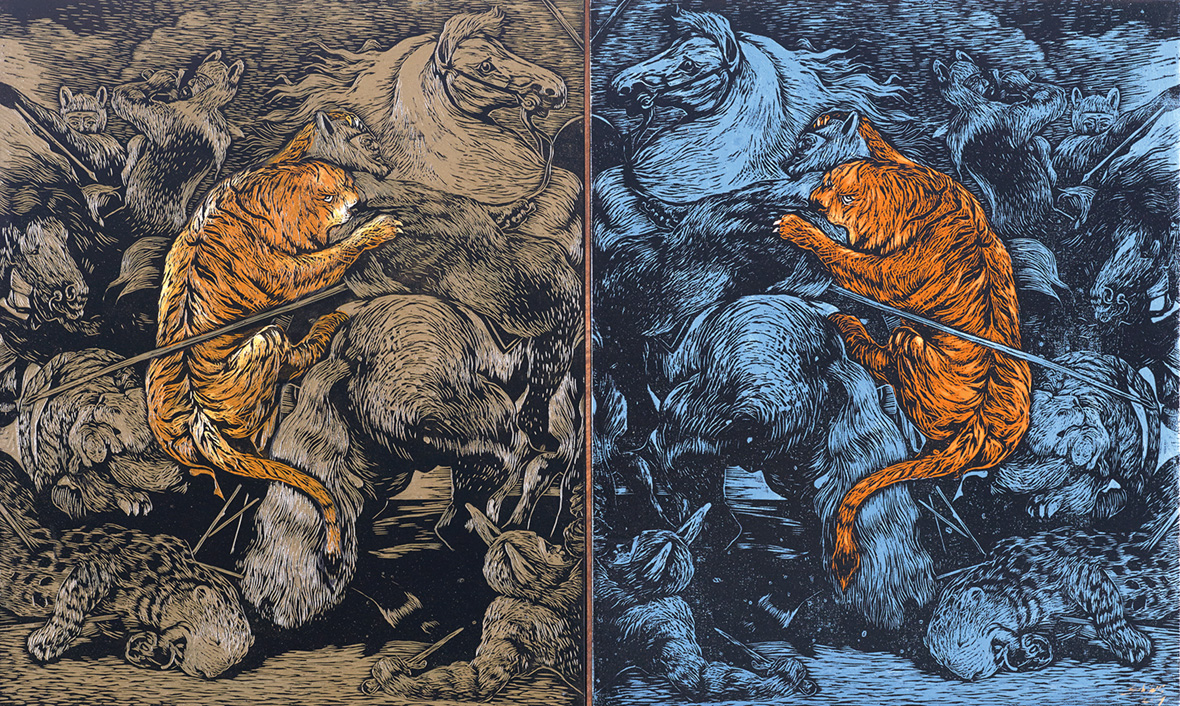
Just because something is steeped in tradition and speaks on important messages doesn’t mean it can’t be fun. Chinese-Malaysian artist Ong Hieng Fuong is a case in point. His work is a fiery blend of horror and humor, with comical characters in torturous circumstances. Each artwork is dripping in fine detail and political opinions. “As time goes on and the development of our country continues, the people and places I depict are gradually disappearing. They’re also repeating the same mistakes that people never cease to make, continuing societal problems in our country that have existed for a long time.”
Raised in Tanjong Sepat, a fishing village on the west coast of Peninsular Malaysia, Hieng discovered printmaking when he studied in Beijing. His professors pointed out that it fits his comics-based and line-driven style well. He was drawn to woodblock printing specifically because it’s low maintenance, allowing him to work from home or wherever he happens to be located. “You have to cut each line and stroke on the woodblock with great care,” he says. “The feel of a woodcut knife definitely shows through in the prints and really affects my style. It’s got a very craftsmanship spirit, so to speak.”
用传统艺术作品来表达观点不一定都是枯燥乏味的,马来西亚华裔艺术家 Ong Hieng Fuong 的作品便是一个很好的例子。他的作品是恐怖与幽默的混合体,往往将滑稽的角色置身于水深火热之中。仔细看,每幅作品都充满精妙细节和深刻的政治观点。“我所描绘的人和地方并不会随时间消逝。人们总是不断重复着同样的错误,由来已久的社会问题仍然存在。”
Hieng 在马来西亚半岛西海岸的一个渔村 Tanjong Sepat 长大,在北京读书期间接触了版画。当时他的老师坚持让他学习这种创作方式,认为这种艺术媒介与他此前一贯的漫画和线描风格可谓换汤不换药。而他喜欢木刻版画的原因在于,这种艺术媒介的维护成本低,他可以在家或任何地方创作。他表示:“在木板上雕刻的每一笔一划都要格外小心。木刻刀的质感必然会在版画中体现出来,也会对我的作品风格有很大的影响。我觉得这种艺术媒介非常有工匠精神。”
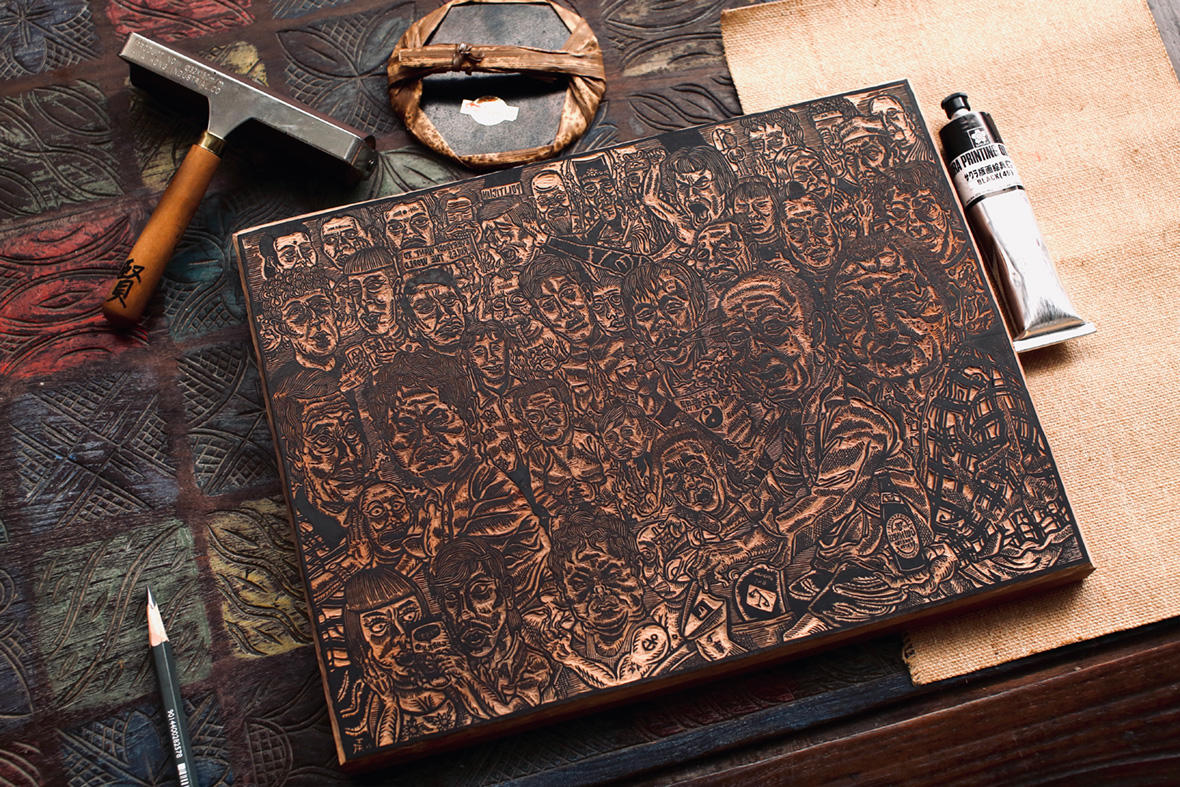
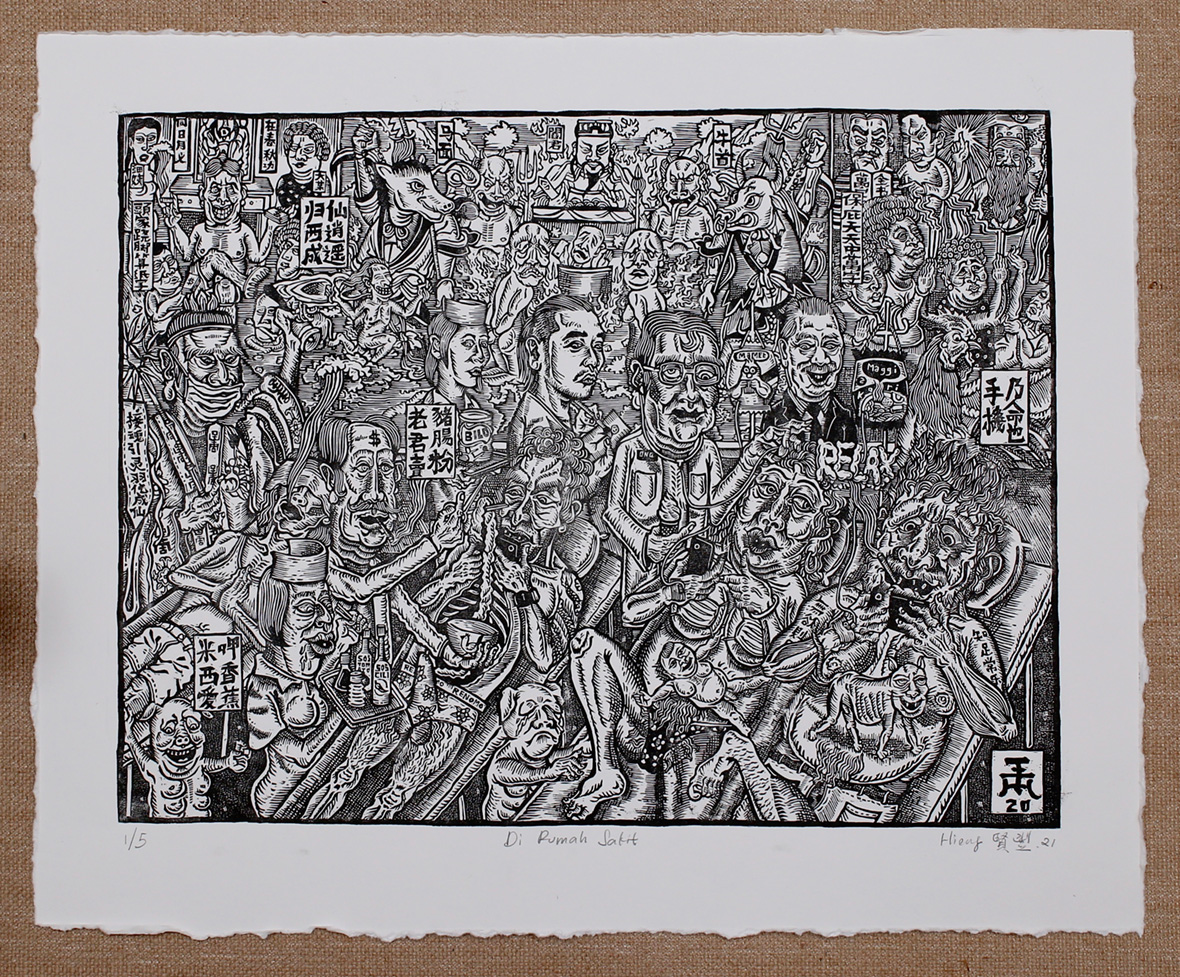
Rico Leong is another woodcut artist who doesn’t believe in being bound by tradition. He works with a few different types of printmaking and leans towards an illustrative style, often collaborating with bands and clothing companies. “The texture of woodcut prints is just special,” the self-taught, Kuala Lumpur-based artist says. While his personal work is pretty jovial compared to the others, he maintains an activist edge as one of Pangrok Sulap’s members, along with his brother Rizo.
Another member of Pangrok Sulap is Bam Hizal, who also works with themes of climate change, deforestation, and activism. He adds a psychological element, believing that the human mind is central to all of these issues. “The basic human condition is not one of satisfaction, but rather a constant craving for more,” he says. “The more we achieve, the more we want. There’s no end to it.” In one untitled print from 2019, a blindfolded person with a clock chained to their foot is shown barreling through the scene, unable to read the book in their hands or to see the puzzle-shaped tiles below. Messages about better ways to approach life sprawl across the ground like well-laid crops as a yonic sun shines overhead.
Rico Leong 可能是马来西亚风格最轻松愉快的木刻艺术家,他从事多种不同类型的版画制作,更倾向于插画,常常与乐队和服装公司合作。这位自学成才的吉隆坡艺术家认为:“木刻版画有很特别的纹理感。”虽然与其他人相比,他的个人作品风格更活泼,但他和 Pangrok Sulap 团体一样,也会积极参与有关社会问题的创作。
Pangrok Sulap 的另一位成员是 Bam Hizal,他的作品常常涉及气候变化、森林砍伐和积极行动主义等主题,并多了一层心理层面的构思。在他看来,人类思维是所有问题的核心。他说:“人类总是不满足,不断渴望更多。取得的越多,想要的就越多,永远也没有尽头。”他在 2019 年创作的一幅未命名版画中,人被蒙住双眼、脚上拴着一个时钟,他们快速穿行,无法阅读,无法辨认周遭,却一意孤行。在他们脚下,关于生活智慧的文字像庄稼一样遍布地面,而他们头上,却是一轮女阴形状的太阳,象征欲望将人的双眼蒙蔽。
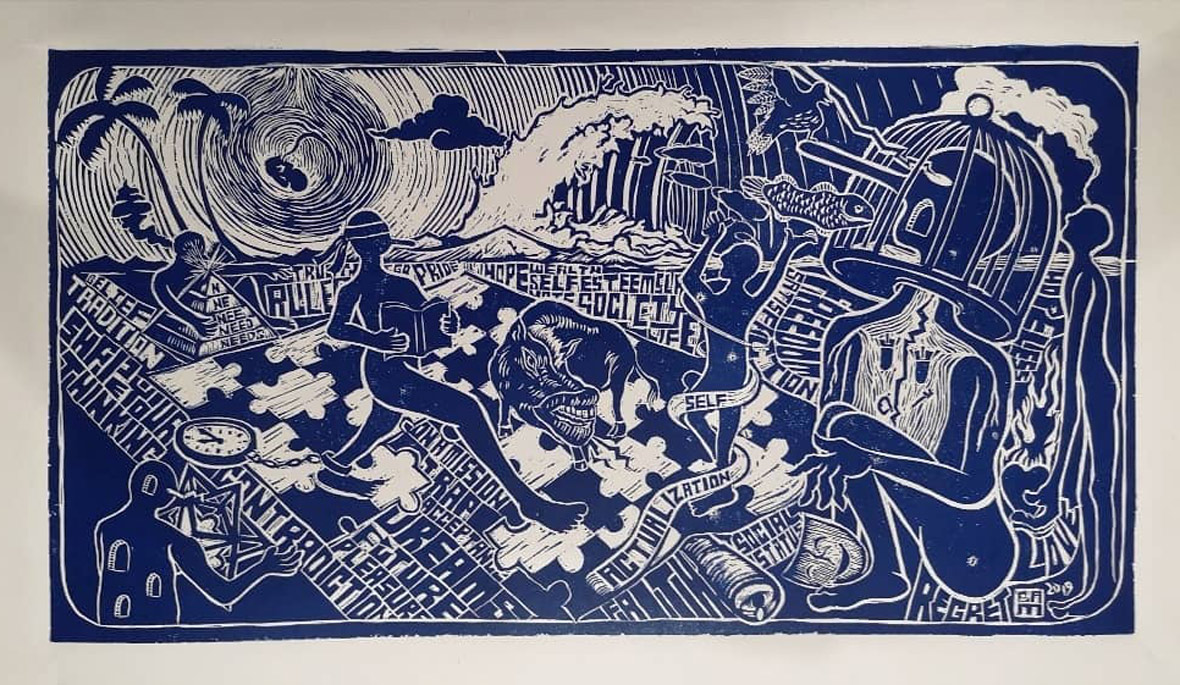

In the view of Hizal, tradition is the way out of this cycle of madness: “Our world provides all that we need to live. The only way we can quit the current system, which places material possession above all else, is to go back and live with mother nature. Our ancestors have proven a sustainable way of life. We have a lot to learn from them!”
The messaging is central for these artists, and the medium attracts them specifically because of how easy it is to spread their ideas. It’s affordable, effective, and can be applied at scale, with numerous prints being made from the same carving. The more people they teach, the farther the message can make it.
Their outlook is positive, and they highlight solutions alongside a celebration of the good humans are capable of. But it’s also impossible to ignore the darkness of their work, which is understandable considering the stakes at hand. Pandi’s focus on the hunter and the hunted is a reflection on his view of modern reality. “Life is about survival now. You can either be predator or prey,” he posits quite bleakly.
Hieng seconds that view: “Suffering is the norm. Life is only occasionally sweet.” But for him, this is all the more reason to appreciate the good in life and cherish what you have. The solidarity among these artists, their admirable goals, their talent, and their dedication are all certainly worth appreciating.
在 Bam 看来,回归传统是摆脱这种疯狂循环的出路:“世界已经提供了我们生活所需的一切。要摆脱现在这种状态——即物质高于一切的心态,就必须回归到大自然生活。我们的祖先已经证明了一种可持续的生活方式。我们应该学他们那样!”
对于这些艺术家来说,传递信息很重要。木刻版画价格便宜、效率高,而且可以大规模印制,同一件木雕,就能印制成大量的作品。这些作品所能影响的人越多,他们的信息就能传播得越远。
他们对前景很乐观,即便再作品中谴责的人类黑暗面,但他们更着眼于解决问题的办法,也常常称赞人类好的方面。Sabihis 关于猎人和猎物的思考也反映了他对当代社会现实的看法。“现在的生活就是生存。你不是捕食者,就是猎物。”他黯然说道。
Hieng 对这种说法表示赞同:“苦难是常态。甜蜜只是生活偶尔的点缀。”但对他来说,也正因如此,更应该去欣赏生活中的美好,珍惜所拥有的一切。这些艺术家之间的团结、伟大的使命、过人的才华与奉献精神无不令人赞赏。
Like our stories? Follow us on Facebook and Instagram.
Instagram: @pangroksulak
Contributor: Mike Steyels
Chinese Translation: Olivia Li

